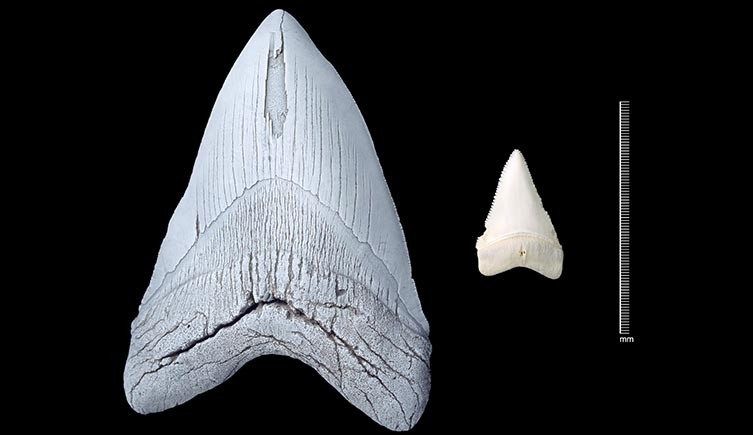Megalodon, the largest shark to ever exist, continues to fascinate. But why did this apex predator vanish from the oceans millions of years ago? This article delves into the potential causes of megalodon’s extinction.
Megalodon’s Size and Diet: Clues to its Demise
Megalodon (Otodus megalodon) ruled the oceans for 13 million years, going extinct roughly 3.6 million years ago. Fossil evidence suggests these massive sharks reached lengths of up to 24.3 meters, dwarfing even the largest great white sharks. Their enormous size necessitated a diet of large prey, including whales, large fish, and other sharks. Fossilized whale bones bearing megalodon teeth marks confirm their predatory habits. Their powerful jaws, filled with 276 teeth, could exert a bite force exceeding 100,000 Newtons, making them one of the most formidable predators in history.
Comparison of Megalodon and Great White Shark teeth. The sheer size difference hints at the massive scale of Megalodon.
The Changing World of the Pliocene: A Recipe for Extinction
The Pliocene epoch (5.3 to 2.6 million years ago) witnessed a period of global cooling, dramatically impacting marine ecosystems. This cooling trend is believed to be a primary factor in megalodon’s extinction. The drop in ocean temperatures likely shrunk megalodon’s preferred warm-water habitat significantly.
Megalodon is believed to have had a similar body shape to the modern blue shark, adapted for warmer waters.
This cooling also affected megalodon’s prey. As water temperatures dropped, prey species may have either gone extinct themselves or migrated to cooler regions inaccessible to the warmth-dependent megalodon. Furthermore, megalodon nurseries, located in shallow coastal waters, would have been devastated by falling sea levels caused by polar ice formation, impacting the survival of young megalodon.
Evidence of Megalodon’s diet: a whale rib bone bearing the distinct scratch marks of Megalodon teeth.
Competition and the Fall of a Giant
Emerging evidence suggests competition with the great white shark, a more adaptable species, might have played a role in megalodon’s decline. Fossil teeth analysis reveals dietary overlap between the two sharks, indicating potential competition for food resources. This competition, coupled with environmental changes, may have pushed megalodon towards extinction.
Debunking the Megalodon Myth: Extinct, Not Hiding
Despite popular myths and fictional portrayals, megalodon is definitively extinct. There is no scientific evidence to support claims of its survival in the deep ocean. If a creature of megalodon’s size still existed, there would be undeniable evidence in the form of bite marks on other large marine animals, abundant teeth on the ocean floor, and sightings.
Megalodon teeth are relatively common fossils, found on every continent except Antarctica. The absence of modern teeth strongly suggests extinction.
Conclusion: A Convergence of Factors
The extinction of megalodon likely resulted from a combination of factors, primarily climate change, habitat loss, prey scarcity, and possibly competition. The changing world of the Pliocene proved too challenging for this giant shark, leading to its disappearance from the oceans millions of years ago. The story of megalodon serves as a powerful reminder of the interconnectedness of ecosystems and the vulnerability of even the most dominant species to environmental change.
The great white shark, a more adaptable species, might have outcompeted Megalodon for food resources during the Pliocene epoch.

